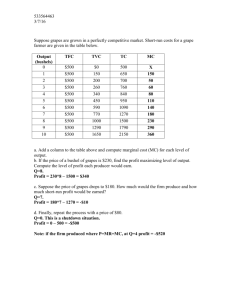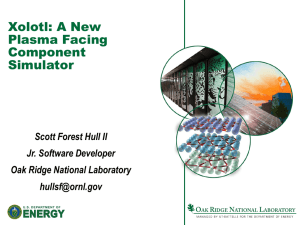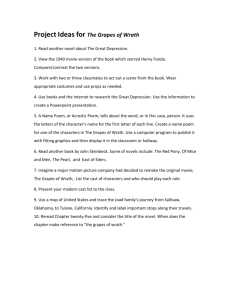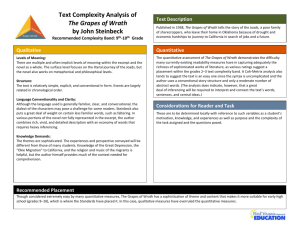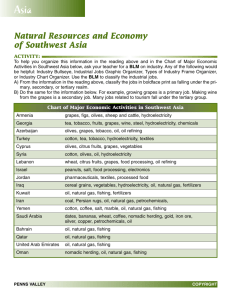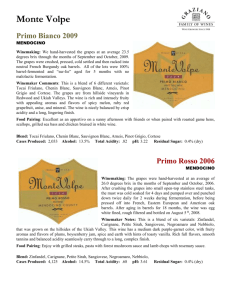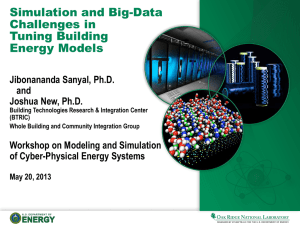Invited Talk - dimacs
advertisement
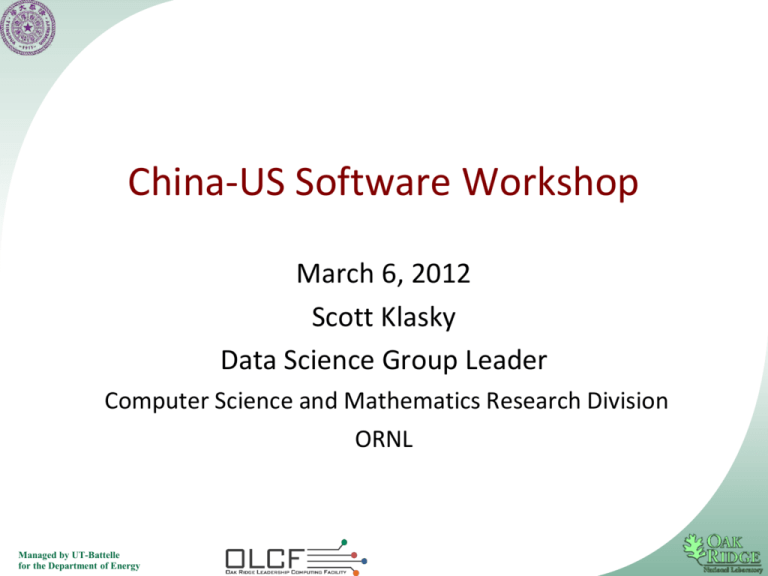
China-US Software Workshop March 6, 2012 Scott Klasky Data Science Group Leader Computer Science and Mathematics Research Division ORNL Managed by UT-Battelle for the Department of Energy Remembering my past • Sorry, but I was a relativist a long long time ago. • NSF funded the Binary Black Hole Grand Challenge 1993 – 1998 • 8 Universities: Texas, UIUC, UNC, Penn State, Cornell, NWU, Syracuse, U. Pittsburgh Managed by UT-Battelle for the Department of Energy The past, but with the same issues R. Matzner, http://www2.pv.infn.it/~spacetimeinaction/speakers/view_transp. php?speaker=Matzner Managed by UT-Battelle for the Department of Energy Some of my active projects • • • • • • • • • • • DOE ASCR: Runtime Staging: ORNL, Georgia Tech, NCSU, LBNL DOE ASCR: Combustion Co-Design: Exact: LBNL, LLNL, LANL, NREL, ORNL, SNL, Georgia Tech, Rutgers, Stanford, U. Texas, U. Utah DOE ASCR: SDAV: LBNL, ANL, LANL, ORNL, UC Davis, U. Utah, Northwestern, Kitware, SNL, Rutgers, Georgia Tech, OSU DOE/ASCR/FES: Partnership for Edge Physics Simulation (EPSI): PPPL, ORNL, Brown, U. Col, MIT, UCSD, Rutgers, U. Texas, Lehigh, Caltech, LBNL, RPI, NCSU DOE/FES: SciDAC Center for Nonlinear Simulation of Energetic Particles in Burning Plasmas: PPPL, U. Texas, U. Col., ORNL DOE/FES: SciDAC GSEP: U. Irvine, ORNL, General Atomics, LLNL DOE/OLCF: ORNL NSF: Remote Data and Visualization: UTK, LBNL, U.W, NCSA NSF Eager: An Application Driven I/O Optimization Approach for PetaScale Systems and Scientific Discoveries: UTK NSF G8: G8 Exascale Software Applications: Fusion Energy , PPPL, U. Edinburgh, CEA (France), Juelich, Garching, Tsukuba, Keldish (Russia) NASA/ROSES: An Elastic Parallel I/O Framework for Computational Climate Modeling : Auburn, NASA, ORNL Managed by UT-Battelle for the Department of Energy Scientific Data Group at ORNL Managed by UT-Battelle for the Department of Energy Name Expertise Line Pouchard Web Semantics Norbert Podhorszki Workflow automation Hasan Abbasi Runtime Staging Qing Liu I/O frameworks Jeremy Logan I/O optimization George Ostrouchov Statistician Dave Pugmire Scientific Visualization Matthew Wolf Data Intensive computing Nagiza Samatova Data Analytics Raju Vatsavai Spatial Temporal Data Mining Jong Choi Data Intensive computing Wei-chen Chen Data Analytics Xiaosong Ma I/O Tahsin Kurc Middleware for I/O & imaging Yuan Tian I/O read optimizations Roselyne Tchoua Portals Top reasons of why I love collaboration • • • • • I love spending my time working with a diverse set of scientist I like working on complex problems I like exchanging ideas to grow I want to work on large/complex problems that require many researchers to work together to solve these Building sustainable software is tough, I want to Managed by UT-Battelle for the Department of Energy ADIOS • Goal was to create a framework for I/O processing that would • • • Enable us to deal with system/application complexity Rapidly changing requirements Evolving target platforms, and diverse teams Interface to apps for descrip on of data (ADIOS) Data Management Services Feedback Buffering Schedule Mul -resolu on methods Data Compression methods Data Indexing (FastBit) methods Plugins to the hybrid staging area Provenance Workflow Engine Run me engine Analysis Plugins Adios-bp IDX HDF5 Visualiza on Plugins ExaHDF “raw” data Parallel and Distributed File System Managed by UT-Battelle for the Department of Energy Data movement Image data Viz. Client ADIOS involves collaboration • Idea was to allow different groups to create different I/O methods that could ‘plug’ into our framework • Groups which created ADIOS methods include: ORNL, Georgia Tech, Sandia, Rutgers, NCSU, Auburn Islands of performance for different machines dictate that there is never one ‘best’ solution for all codes • New applications (such as Grapes and GEOS-5) allow new methods to evolve • • Sometimes just for their code for one platform, and other times ideas can be shared Managed by UT-Battelle for the Department of Energy ADIOS collaboration Apps: GTC-P (PPPL, Columbia), GTC (Irvine), GTS (PPPL), XGC (PPPL), Chimera (ORNL), Genesis (ORNL), S3D (SNL), Visit (LBNL), GEOS-5 (NASA), Raptor (Sandia), GKM (PPPL), CFD (Ramgen), Pixie3D (ORNL), M3D-C1 (PPPL), M3D(MIT), PMLC3D (UCSD), Grapes (Tsinghua ), LAMMPS (ORNL) Interface to apps for descrip on of data (ADIOS) (ORNL, GT, Rutgers) Data Management Services Feedback Buffering Mul -resolu on methods: Auburn, Utah Data Compression methods (NCSU) Schedule Data Indexing methods (LBNL, NCSU) Plugins to the hybrid staging area (Sandia) Provenance Workflow Engine (UCSD) Run me engine Analysis Plugins (Davis, Utah, OSU, BP: UTK IDX Utah GRIB2 ExaHDF LBNL Visualiza on Plugins Netcdf-4 Sandia Parallel and Distributed File System, Clouds (Indiana) Managed by UT-Battelle for the Department of Energy Data movement LBNL Image data Emory Viz. Client Kitware Sandia, Utah What do I want to make collaboration easy I don’t care about clouds, grids, HPC, exascale, but I do care about getting science done efficiently • Need to make it easy to • • Share data • Share codes • Give credit without knowing who did what to advance my science • Use other codes and tools and technologies to develop more advanced codes • Must be easier than RTFM • System needs to decide what to be moved, how to move it, where is the information • I want to build our research/development from others Managed by UT-Battelle for the Department of Energy Need to deal with collaborations gone bad bobheske.wordpress.com • I have had several incidents where “collaborators” become competitors • Worry about IP being taken and not referenced • Worry about data being used in the wrong context • Without record of where the idea/data came from it makes people afraid to collaborate Managed by UT-Battelle for the Department of Energy Why now? • Science has gotten very complex • Science teams are getting more complex • Experiments have gotten complex • More diagnostics, larger teams, more complexities Computing hardware has gotten complex • People often want to collaborate but find the technologies too limited, and fear the unknown • Managed by UT-Battelle for the Department of Energy What is GRAPES • GRAPES: Global/Regional Assimilation and PrEdiction System developed by CMA ATOVS资料 预处理 QC Managed by UT-Battelle for the Department of Energy Analysis field Static Data GRAPES input Filter QC Initialization GTS data Global 6h forecast field GRAPES Global model Background field 3D-VAR DATA ASSIMILATION Global 6h forecast field 6h cycle, only 2h for 10day global prediction Grads Output Modelvar postvar Database Regional model Development plan of GRAPES in CMA After 2011, Only use GRAPES model GFS Pre-operation System upgrade GRAPES GFS 25km GRAPES GFS 50km T639L60-3DVAR+Model Pre-operation Operation Operation higher resolution is a key point of future GRAPES AIRS selected channel FY3-ATOVS, FY2-Track wind QuikSCAT Grapes-global-3DVAR 50km, Operation GPS/COSMIC GDAS Operation 2006 EUmetCASTATOVS Global-3DVAR NESDIS-ATOVS, More channel Managed by UT-Battelle for the Department of Energy 2007 Operation Operation Operation 2008 2009 2010 2011 Why IO? Grapes_input and colm_init are Input func. Med_last_solve_io/med_before_solve_io are output func. 120.0% IO dominates the time of GRAPES when > 2048p 100.0% 80.0% med_last_solve_io 60.0% solver_grapes med_before_solve_io colm_init 40.0% grapes_input 20.0% 25km H-resolution Case Over Tianhe-1A Managed by UT-Battelle for the Department of Energy /通用格式 /通用格式 /通用格式 /通用格式 /通用格式 /通用格式 /通用格式 /通用格式 /通用格式 /通用格式 /通用格式 /通用格式 /通用格式 /通用格式 /通用格式 /通用格式 /通用格式 /通用格式 /通用格式 /通用格式 /通用格式 /通用格式 /通用格式 /通用格式 /通用格式 /通用格式 0.0% Typical I/O performance when using ADIOS • High Writing Performance (Most codes achieve > 10X speedup over other I/O libraries) • S3D 32 GB/s with 96K cores, 0.6% I/O overhead • XGC1 code 40 GB/s, SCEC code 30 GB/s • GTC code 40 GB/s, GTS code 35 GB/s • Chimera 12X performance increase • Ramgen 50X performance increase 1000 Read Throughput (MB/Sec) Read Throughput (MB/Sec) 1000 100 10 1 ik ij 100 10 1 LC Managed by UT-Battelle for the Department of Energy jk Chunking LC ADIOS Chunking Details: I/O performance engineering of the Global Regional Assimilation and Prediction System (GRAPES) code on supercomputers using the ADIOS framework GRAPES is increasing the resolution, and I/O performance must be reduced • GRAPES will begin to need to abstract I/O away from a file format, and more into I/O services. • • One I/O service will be writing GRIB2 files • Another I/O service will be compression methods • Another I/O service will be inclusion of analytics and visualization Managed by UT-Battelle for the Department of Energy Benefits to the ADIOS community More users = more sustainability • More users = more developers • Easy for us to create I/O skeletons for next generation system designers • Managed by UT-Battelle for the Department of Energy Skel • • • • • Skel is a versatile tool for creating and managing I/O skeletal applications Skel generates source code, makefile, and submission scripts The process is the same for all “ADIOSed” applications Measurements are consistent and output is presented in a standard way One tool allows us to benchmark I/O for many applications grapes.xml skel params skel xml grapes_params.xml grapes_skel. xml skel src skel makefile skel submit Source files Makefile Submit scripts make Executables Managed by UT-Battelle for the Department of Energy make deploy skel_grapes What are the key requirements for your collaboration - e.g., travel, student/research/developer exchange, workshop/tutorials, etc. • Student exchange • Tsinghua University sends student to UTK/ORNL (3 months/year) • Rutgers University sends student to Tsinghua University (3 months/year) • Senior research exchange • UTK/ORNL + Rutgers + NCSU send senior researchers to Tsinghua University (1+ week * 2 times/year) • Our group prepares tutorials for Chinese community • Full day tutorials for each visit • Each visit needs to allow our researchers access to the HPC systems so we can optimize • Computer time for teams for all machines • Need to optimize routines together, and it is much easier when we have access to machines • 2 phone calls/month Managed by UT-Battelle for the Department of Energy Leveraging other funding sources • NSF: EAGER proposal, RDAV proposal • Work with Climate codes, sub surfacing modeling, relativity, … • NASA: ROSES proposal • Work with GEOS-5 climate code • DOE/ASCR • Research new techniques for I/O staging, co-design hybrid-staging, I/O support for SciDAC/INCITE codes • DOE/FES • Support I/O pipelines, and multi-scale, multi-physics code coupling for fusion codes • DOE/OLCF • Support I/O and analytics on the OLCF for simulations which run at scale Managed by UT-Battelle for the Department of Energy What the metrics of success? • Grapes I/O overhead is dramatically reduced • Win for both teams • ADIOS has new mechanism to output GRIB2 format • Allows ADIOS to start talking to more teams doing weather modeling • Research is performed which allow us to understand new RDMA networks • New understanding of how to optimize data movement on exotic architecture • • • New methods in ADIOS that minimize I/O in Grapes, and can help new codes New studies from Skel give hardware designers parameters to allow them to design file systems for next generation machines, based on Grapes, and many other codes Mechanisms to share open source software that can lead to new ways to share code amongst a even larger diverse set of researchers Managed by UT-Battelle for the Department of Energy I/O performance engineering of the Global Regional Assimilation and Prediction System (GRAPES) code on supercomputers using the ADIOS framework Need for and impact of China-US collaboration Objectives and significance of the research Improve I/O to meet the time-critical requirement for operation of GRAPES Improve ADIOS on new types of parallel simulation and platforms (such as Tianhe-1A) Extend ADIOS to support the GRIB2 format Feed back the results to ADIOS and help researchers in many communities Approach and mechanisms; support required Monthly teleconference Student exchange Meetings at Tsinghua University with two of the ADIOS developers Meeting during mutual attended conferences (SC, IPDPS) Joint publications Managed by UT-Battelle for the Department of Energy Connect I/O software from the US with parallel application and platforms in China Service extensions, performance optimization techniques, and evaluation results will be shared Faculty and student members of the project will gain international collaboration experience Team & Roles Dr. Zhiyan Jin, CMA, Design GRAPES I/O infrastructure Dr. Scott Klasky, ORNL, Directing ADIOS, with Drs. Podhorszki, Abbasi, Qiu, Logan Dr. Xiaosong Ma, NCSU/ORNL, I/O and staging methods, to exploit in-transit processing to GRAPES Dr. Manish Parashar, RU, Optimize the ADIOS Dataspace method for GRAPES Dr. Wei Xue, TSU, Developing the new I/O stack of GRAPES using ADIOS, and tuning the implementation for Chinese supercomputers

